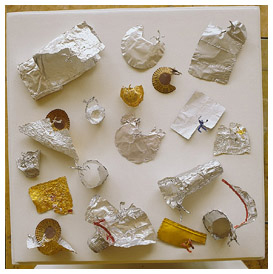


 |


Franklin Cassaro manipulates common materials such as newspaper, tin foil, product packaging, audiotapes, and cough drops to construct sculptures that provocatively conflate the organic and the inert. Originally trained in the sciences, Cassaro approaches artistic production with the sensibility of a renegade researcher, treating his sculptural investigations as quasi-scientific explorations into the potential evolution of plastic forms. In each of his sculptural acts the artist almost obsessively transforms this wide range of vernacular materials into new organic imaginary forms that in their multiple repetitions evolve with an almost Darwinian logic.
Categorizing his artistic production as "bio-concretism," Cassaro joins a scientific concern with biological morphology and taxonomy to his fascination with the phenomenological and social bases of the artistic production of Brazilian Neo-concrete artists of the 1950s and 1960s, including Hélio Oiticica and Lygia Clark. Cassaro creates families of organic forms, including his "inflatables," large tentlike structures made out of newsprint and packing tape or materials such as Mylar. The inflatables are activated by the movement of air, whether from an electric fan or the wind, and can be entered by the visitor. This is the legacy of the Neo-concretists, suggesting that the work can only be completed by the physical interaction of subjects moving through the world. Other subspecies of Cassaro's work trace the evolutionary development of bio-concretist forms in a variety of different materials. Whether constructing basic inflatable shelters out of newsprint and tape, creating Paleolithic drawings of reptiles on paper with his teeth, exploring the formal characteristics of plastic film canisters when exposed to heat, or transforming an audio cassette tape into a bird on a nest, Cassaro's work is always evocative of the artist's body moving through space. As he further develops his bio-concretist program, he continues to blur the lines between the figurative and the abstract, the organic and the man-made. Whatever their material, his sculptures are inextricably linked by an artistic process that negotiates the terrain of the modern world via an incessant, quasi-scientific investigation of the evolution of form and the movement of the body through space.
Cassaro's work has been featured in a number of solo exhibitions at venues such as the Museu de Arte da Pampulha, Belo Horizonte, Brazil (2002), and the Museu de Arte Moderna, Rio de Janeiro (2001). His work has also been included in a number of group exhibitions such as Shift at the Center for Curatorial Studies, Bard College, Annandale-on-Hudson, New York (2002); VII Bienal de La Habana, Havana, Cuba (2000-2001); and Transformal at the Wiener Secession, Vienna, Austria (1996).
--Douglas Fogle











